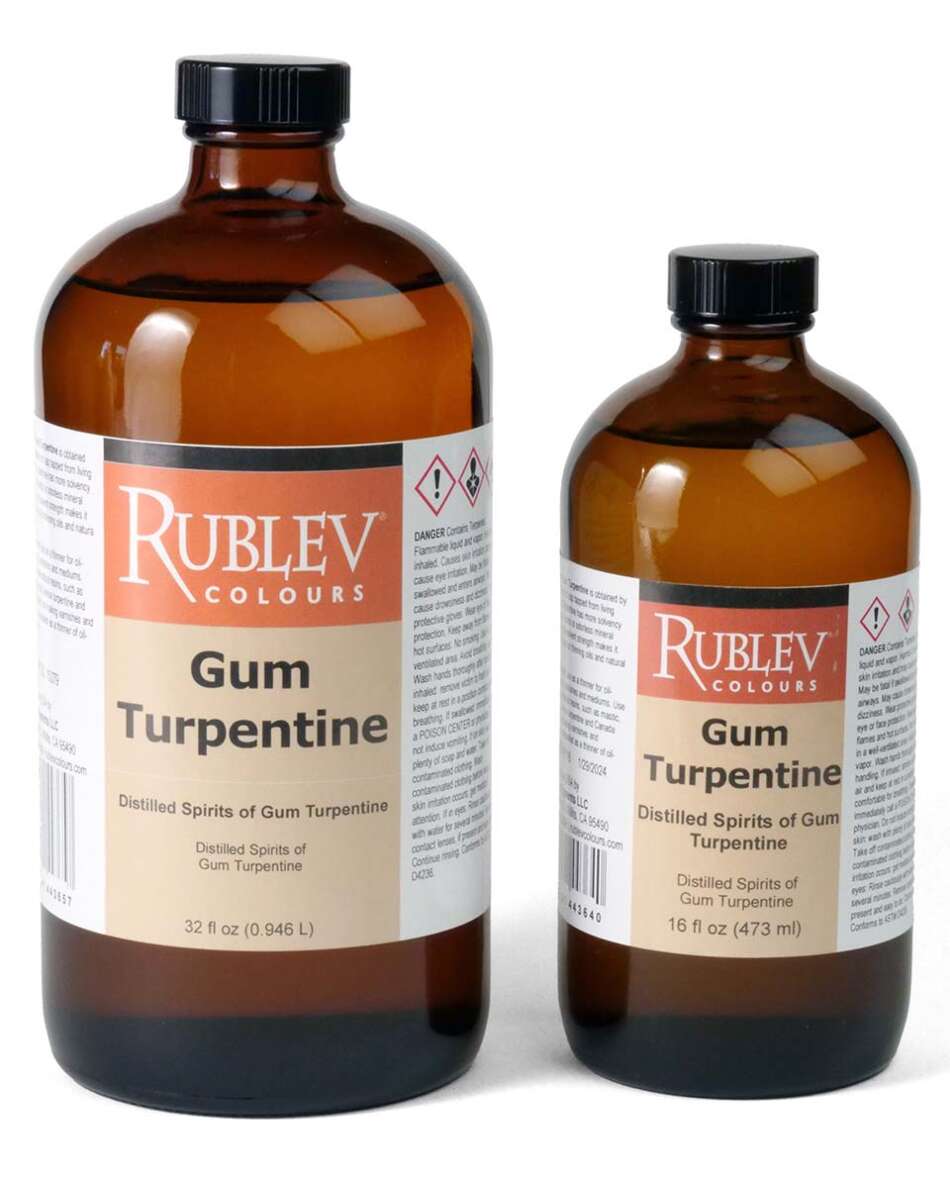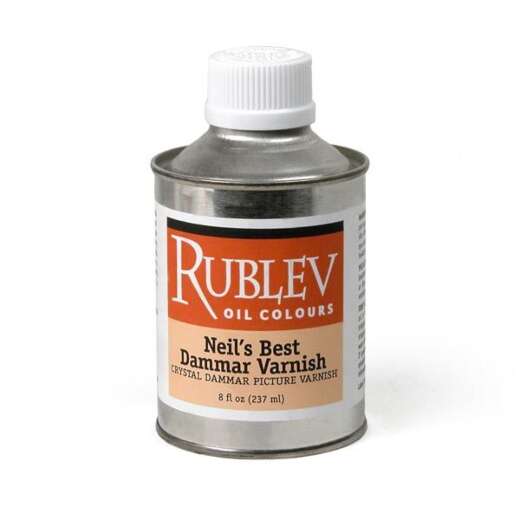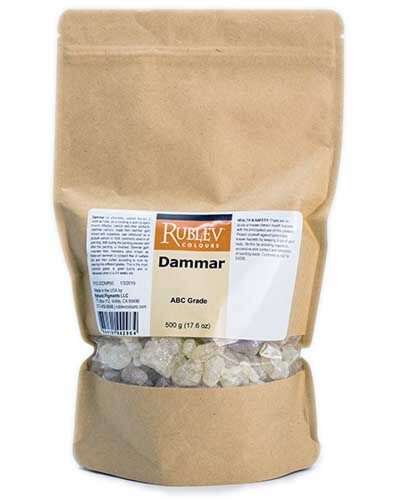Gum turpentine, when stored properly in a cool, dry place away from direct sunlight and tightly sealed, can last for several years without significant degradation.
100% Pure Artists Gum Turpentine - Ideal for Oil Painting
Pure spirits of gum turpentine for use with linseed or other oils as a medium, with damar or mastic as a diluent for picture varnishes or as a solvent for cleaning tools. Learn more.
Gum Spirits of Turpentine is obtained by distilling sap from living pine trees. Turpentine has more solvency than mineral spirits or odorless mineral spirits. Its high solvent strength makes it the best choice for thinning oils and natural resins.
Our pure spirits of gum turpentine is steam-distilled (rectified) from pine trees (Pinus elliottii) in Brazil, a species often used as the benchmark by which others are judged. It contains over 90% pinene, almost half of which is beta-pinene, and virtually no high-boiling constituents. It does not contain impurities found in industrial turpentine grades, making them unsuitable for artists’ use. It is used with linseed or other oils as a medium, with dammar or mastic as a diluent for picture varnishes, or as a solvent for cleaning brushes and tools.
Traditional Artists’ Thinner
This is the traditional artists’ thinner (diluent) for oil colors, mediums, and varnishes. It improves the flow, dissolves wet oil colors easily, and evaporates readily. Add directly to oil colors, mediums, or varnishes for thinning; soak brushes well to remove color or varnish.
Turpentine is considered a better solvent than mineral spirits and the best solvent for natural resins, such as dammar and mastic. It readily dissolves most of the natural varnish resins. It will not dissolve the fossil resins (copal) until they have been heat-processed to render them soluble in drying oils. Turpentine is a solvent for many of the alkyd resins. Short oil-modified alkyd resins require a more active solvent, so manufacturers use d-limonene (dipentene) or petroleum solvents.
While turpentine and mineral spirits are good brush cleaners, turpentine can remove paint that has hardened slightly. Mineral spirits will only dissolve fresh oil paint.
Differences Between Turpentines—Wood, Kraft and Gum
Gum turpentine or spirits of gum turpentine is recommended for artists’ painting or varnish applications over other turpentine products, such as wood turpentine. The principal difference between the turpentine products available today—gum turpentine and wood turpentine—is the constituent b-pinene, which is almost entirely absent from wood turpentine. Wood turpentine can be used as a solvent for oil paint, but gum turpentine is more suitable for natural varnishes.
What is the Difference Between Rectified or Distilled Turpentine
All gum turpentine sold is steam-distilled, and the labels of “double” or “triple distilled” is a point of distinction that has little or no real meaning in commerce today. Rectified turpentine is the term used in the United Kingdom to signify distilled turpentine.
Some believe that turpentine aged “several months” is a superior thinner and increases its durability. This recommendation was often encountered in nineteenth-century artists’ manuals, but its efficacy is unknown. Turpentine, stored for 15 to 18 months, still passes the ASTM tests, so the degree of oxidation developed under normal storage conditions during this period is not great.
How to Properly Store Turpentine
When exposed to air and light, turpentine may darken because it develops hydroperoxides, acids, and other by-products that can attack metal storage containers. Darkening may also occur in plastic containers since these are permeable to oxygen. Here is some technical information about turpentine:
“Chemically speaking, turpentine is a highly unsaturated body. It combines directly with oxygen, chlorine, bromine, iodine, hydrogen chloride, nitric acid, sulphuric acid, and many other chemically active substances. On standing for some time in a partially filled container, especially when exposed to the light, or on exposure to the air for a shorter period in the form of a thin film, turpentine absorbs oxygen from the air (becomes oxidized). At the same time, small quantities of hydrogen peroxide are liberated. It will be noticed that the cork stopper from a bottle partially filled with turpentine is bleached, like the cork in a bottle of hydrogen peroxide. As a result of the absorption of oxygen, the turpentine becomes more viscous and oily and turns yellow, a solid white deposit often forming at the bottom of the bottle. The odor becomes sharp and disagreeable, the specific gravity, the refractive index, and the boiling point are raised, and the percentage distilling up to certain limits becomes less. Small quantities of acetic and other acids are formed in the turpentine. These attack the tin or iron of a can or tank in which the turpentine may be stored, and the dissolved iron helps to darken the color. For this reason, turpentine should not be stored in partially filled iron or tin cans or tanks unless they have first been painted inside with a turpentine-resisting paint.”
“Spirits of turpentine is believed to owe its superiority as a paint thinner to its property of absorbing oxygen from the air, the drying of paint being due to the absorption of oxygen from the air by the linseed or other drying oil, forming a hard, insoluble film of linoxyn. It is said that turpentine acts as an oxygen carrier, transferring oxygen from the air to the linseed oil, and finally adding to the paint film the nonvolatile residue left after evaporation, which also acts like a drying oil.”
Source: Fletcher Pearre Veitch and Victor Edward Grotlisch, Turpentine: Its Sources, Properties, Uses, Transportation, and Marketing, with Recommended Specifications, U.S. Department of Agriculture, Bulletin Number 898, U.S. Department of Agriculture, 1921, pp. 5–6.
What is the best packaging for the sale and storage of turpentine that results in the best product? We opted for amber glass bottles that are not permeable to oxygen, as is plastic, and prevent exposure to light, which is also detrimental to the properties of turpentine. However, once a package is partially empty, this may cause darkening of the turpentine if stored in the can for extended periods. If you do not use all the turpentine within a reasonable time, we recommend pouring the partial contents into smaller glass containers with less air space.
Turpentine Specifications
This product meets Federal Specification TT-T-801.
| Properties | |
| Product Name: | Gum Turpentine (Produced in Brazil) Oil of Turpentine (Mixture of bicyclic monoterpenic hydrocarbons, mostly α and β-pinene) |
| CAS No.: | Gum Turpentine: 9005-90-7 Oil of Turpentine: 8006-64-2 |
| EINECS No.: | 232-350-7 |
| Flash Point (TCC): | 95° F (35° C) |
| Flash Point (Open Cup): | 120°F (49°C) |
| Refractive Index: | 1.465–1.478 |
| Specific Gravity (H2O=1): | 0.865–0.875 |
| Evaporation Rate (Ether=1): | <1.0 |
| Typical Constituents | |
| α-Pinene (CAS No. 80-56-8): | 40–55% |
| β-Pinene (CAS No. 127-91-3): | 30–40% |
| Other Terpenes: | 3–10% |
How to Use Turpentine
Use as a thinner for oil-based paints, varnishes, and mediums. Use it to dissolve natural resins, such as mastic, dammar, Venice turpentine, and Canada balsam, for making varnishes and mediums. Unexcelled as a thinner of oil-based paints.
Directions: Use turpentine to dissolve paint, varnish, or mediums, then wash off the residue in warm, soapy water, and finally rinse in clean water.
Health and Safety
Ecological Impact: Turpentine is a natural product, and its components are entirely biodegradable within a few days, depending on the dilution degree, temperature, air supply, and bacteria present.
WARNING! Contains terpene hydrocarbons. Flammable liquid and vapor. It is harmful if swallowed, inhaled, or absorbed through the skin. Affects the central nervous system. Irritates skin, eyes, and respiratory tract. Overexposure may result in nausea, headache, dizziness, confusion, or instability.
PRECAUTIONS: Avoid prolonged contact with skin and breathing vapors. Keep away from eyes. Keep away from heat or flame. Use the exhaust fan to ensure adequate ventilation. KEEP OUT OF REACH OF CHILDREN.
FIRST AID: If swallowed, do not induce vomiting; give edible oil to drink and get prompt medical attention. If eye irritation occurs, rinse with water for at least 15 minutes. If irritation persists, seek medical care. If skin irritation occurs, wash the affected area with copious amounts of soap and water. If symptoms of overexposure occur, move to fresh air. If symptoms persist, see a physician. For further health information, contact a local poison control center or call 1-800-445-7067.
COMBUSTIBLE LIQUID! United States Department of Transportation (DOT) shipping regulations require that this item can only be shipped surface or ground. No international shipments and no air shipments are allowed. Combustible liquids are shipped by UPS Ground only, allowing 5–10 business days. Due to DOT regulations, all combustible items must be shipped in separate boxes. Combustible items cannot be returned and will ship only to the 48 contiguous states. Multiple quantities of the same item must ship in separate containers—no combustible shipments to PO boxes. Call customer service with questions at 888-361-5900.
Note: This item may not qualify for the Natural Pigments free shipping promotions.
Frequently Asked Questions
How long does gum turpentine last?
How poisonous is mineral turpentine?
Mineral turpentine is another name for mineral spirits and can be toxic if ingested, inhaled in large quantities, or comes into prolonged contact with the skin. It's important to use it in well-ventilated areas and follow safety guidelines.
Is gum turpentine the same as mineral spirits?
No, gum turpentine is distilled from pine resin, while mineral spirits are petroleum-based. They have different properties and uses in art and industry.
Is pure gum turpentine safe?
Pure gum turpentine can be used safely with proper ventilation, protective gear, and adherence to safety guidelines. It should not be ingested or come into prolonged contact with skin.
Is pure gum turpentine toxic?
Yes, pure gum turpentine can be toxic if inhaled in large quantities, ingested, or absorbed through the skin. Always use it in a well-ventilated area and follow safety precautions.
Is turpentine good for your lungs?
No, inhaling turpentine vapors can irritate the lungs and respiratory tract. It's important to use it in well-ventilated areas to minimize inhalation risks.
What are the side effects of turpentine gum spirits?
Side effects can include skin irritation, respiratory problems, headaches, and dizziness, particularly if used in poorly ventilated areas or without proper safety precautions.
What is a substitute for gum turpentine?
Suitable substitutes include mineral spirits for thinning oil-based paints and citrus-based solvents, which are less toxic and have a more pleasant odor.
What is a substitute for mineral spirits?
Alternatives to mineral spirits include turpentine, acetone, and citrus-based solvents, depending on the application and desired properties.
What is gum spirits of turpentine good for?
Gum spirits of turpentine are ideal for thinning oil-based paints, varnishes, and mediums in art due to their high solvent strength and ability to improve paint flow and drying time.
What is the difference between mineral turpentine and gum turpentine?
Mineral turpentine is a petroleum distillate used as a paint thinner, while gum turpentine is distilled from pine resin and is preferred in art for its solvent properties and natural origin.
| SKU | 520-1TRPT |
|---|---|
| Brand | Rublev Colours |
| Vendor | Natural Pigments |
| Processing Time | Usually ships the next business day. |
DANGER! CONTAINS TURPENTINE. Causes skin irritation and serious eye damage. It may cause respiratory irritation. Avoid breathing dust and wash exposed skin thoroughly after handling. Do not eat, drink, or smoke when using this product. Read the SDS for all cautionary statements. Conforms to ASTM D 4236.
Hazard Pictograms
 | 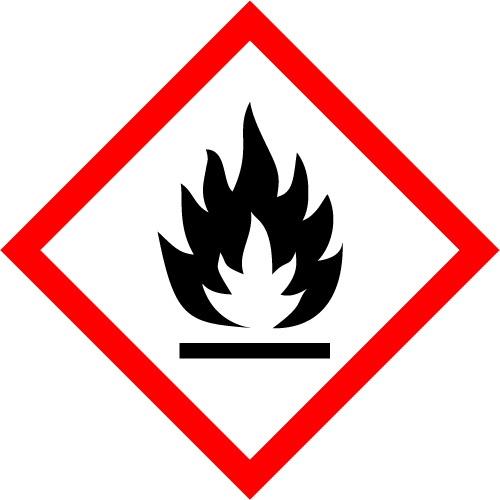 | 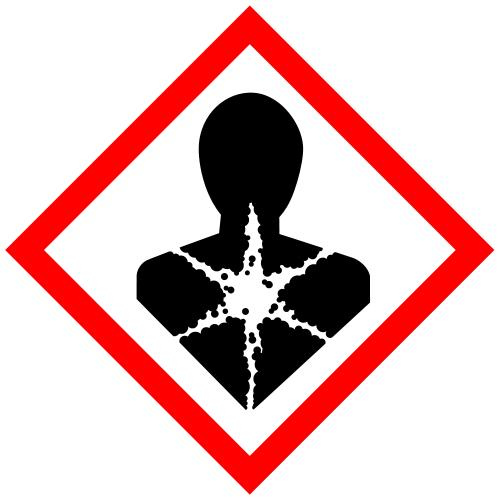 |
| GHS07: Exclamation Mark | GHS02: Flammable | GHS08: Serious Health Hazard |
Signal Word: Danger
Hazard Designation
H226 Flammable liquid and vapor.
H302 + H312 + H332 Harmful if swallowed, in contact with skin or if inhaled
H304 May be fatal if swallowed and enters airways.
H315 Causes skin irritation.
H317 May cause an allergic skin reaction.
Safety Designation
P210 Keep away from heat/sparks/open flames/hot surfaces. No smoking.
P233 Keep container tightly closed.
P242 Use only non-sparking tools.
P243 Take precautionary measures against static discharge.
P261 Avoid breathing dust/fume/gas/mist/vapors/spray.
P264 Wash skin thoroughly after handling.
P270 Do not eat, drink, or smoke when using this product.
P271 Use only outdoors or in a well-ventilated area.


